Christmas Standing Rib Roast
Thanksgiving is a holiday in which turkey really shines. Many of you would rather not deal with another turkey just four weeks after Thanksgiving. But what about a standing rib roast?
Some of you might still have some frozen leftovers. The Christmas meal is celebratory; as such, celebration food is natural at the Christmas dinner table. Enter the standing rib roast.
When deciding how large a roast you’ll need (how many ribs), figure on 1 rib per every two to three people. For example, if you are serving eight people, you will want to purchase a 4-rib roast to ensure generous servings. If you serve other meats at the dinner, you could purchase a 3-rib roast.
What Is A Standing Rib Roast?
A standing rib roast, often called a prime rib, is a timeless classic among meat lovers, renowned for its succulence, tenderness, and rich flavor. This cut of beef is taken from the primal rib section of the animal, typically consisting of ribs six through twelve.
What distinguishes a standing rib roast is that it is cooked with the bones still attached, lending both flavor and structural support during the cooking process and contributing to its exceptional taste and juiciness.
The marbling of fat within the meat is what makes standing rib roast truly exceptional. This intramuscular fat imparts flavor and ensures that the meat remains moist and tender throughout the cooking process. When properly cooked, the fat melts into the meat, infusing it with its delicious essence and creating a sumptuous, luxurious, and comforting texture.
Preparing a standing rib roast is a culinary ritual that commands attention and care. Before cooking, the roast is often seasoned generously with a mixture of herbs, spices, and perhaps a rub of minced garlic, enhancing its natural flavors and creating a tantalizing aroma.
Some chefs prefer to sear the roast at high temperatures before slow-roasting it to perfection. In contrast, others opt for a lower and slower approach from start to finish, allowing the meat to gently cook until it reaches the desired level of doneness.
One of the defining characteristics of a standing rib roast is the bone-in presentation, which not only adds flavor but also creates an impressive visual appeal. As the roast cooks, the bones impart additional richness to the surrounding meat, resulting in a depth of flavor that is unmatched by boneless cuts.
Moreover, serving a standing rib roast with the bones intact adds an element of drama to the dining experience, making it a centerpiece fit for any special occasion or holiday feast.
A standing rib roast is more than just a cut of beef; it is a culinary masterpiece that embodies the essence of indulgence and tradition. From its succulent meat to its flavorful fat and bone-in presentation, every aspect of this dish is designed to delight the senses and elevate the dining experience to new heights of gastronomic pleasure. Whether enjoyed with family and friends or savored as a solo indulgence, a standing rib roast will leave a lasting impression on anyone fortunate enough to partake in its splendor.
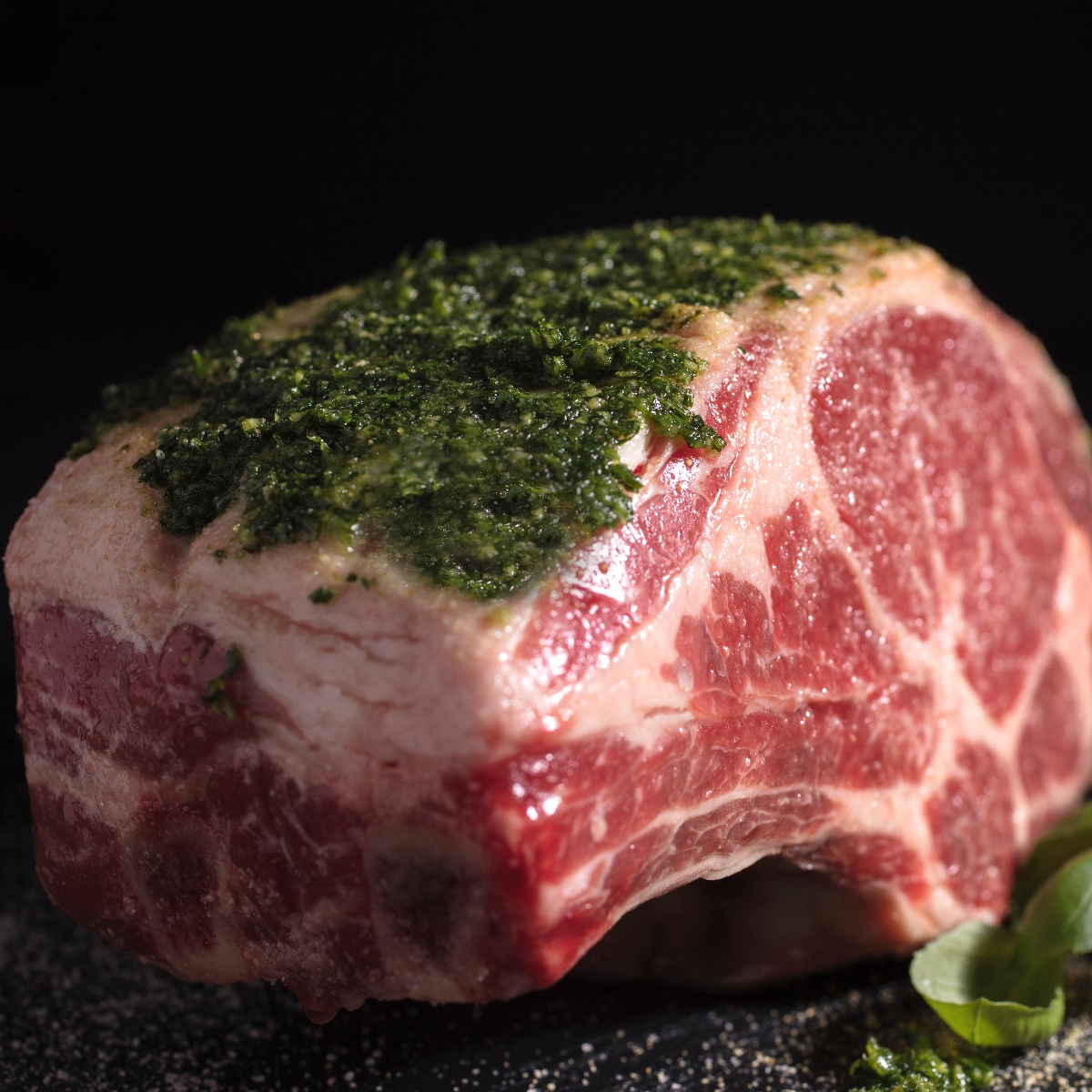
Buying a Standing Rib Roast
When buying the roast, ask your butcher to separate the rack of bones, trim the roast, then tie the bones and the roast together. Having a trained butcher do this for you is much easier than doing it yourself.
Meat Grades
Get the best piece of meat you can find and afford. Prime is the most expensive but will have the most marbling and flavor. Marbled meat has thin lines of intramuscular fat running throughout the meat.
This may turn some people off, but this fat gives the beef extra flavor. Only 2% of all beef produced in the US is grated prime, so it is hard to find and, as I said, very expensive.
Your next choice is Choice. Most of your higher-end supermarkets and places like Costco sell Choice, but be sure to look on the label to be sure. I recommend you avoid Select grade.
Dry Aged Beef
If you can find dry-aged meat and want to spend the bucks, give it a try. It has a distinctive taste that not everyone enjoys, so I recommend you try dry-aged beef on a small cut of beef for the first time and decide for yourself.
Since some bacterial action has started to break down the tissues, the meat will be very tender. The flavor will also be concentrated because some water evaporates from the meat.
Prepping the Roast
Talk about letting the butcher trim out the rib roast unless you have great knife skills and a good boning knife.
There are several reasons why it might be advantageous to let the butcher trim the rib roast rather than attempting to do it yourself:
- Expertise: Butchers are trained professionals with expertise in handling and preparing meat. They have the knowledge and experience to trim the rib roast properly, ensuring it is trimmed to perfection without wasting any meat.
- Precision: Butchers have the tools and skills to trim the rib roast precisely, removing excess fat, silverskin, and connective tissue while preserving the desirable marbling within the meat. This precision results in a more evenly cooked and flavorful roast.
- Time-saving: Trimming a rib roast can be time-consuming, especially if you’re unfamiliar with the process. Allowing the butcher to trim the roast saves you time and effort, allowing you to focus on other aspects of meal preparation.
- Safety: Butchers have the necessary equipment, such as sharp knives and proper sanitation practices, to trim the rib roast safely. Attempting to trim the roast yourself without the proper tools or knowledge could result in injury.
- Consistency: Butchers can ensure that each rib roast is trimmed consistently, resulting in uniform cooking and serving portions. This consistency is especially important if you’re cooking multiple rib roasts for a large gathering or event.
- Quality assurance: By entrusting the trimming process to a professional butcher, you can have confidence in the quality of the final product. Butchers select the best cuts of meat and take care to trim them to the highest standards, ensuring a delicious and satisfying dining experience.
Letting the butcher trim the rib roast offers convenience, quality, and peace of mind, allowing you to enjoy a perfectly trimmed roast without the hassle or uncertainty of doing it yourself.
Remove the roast from the refrigerator about two hours before you are ready to roast it. Before putting it into the oven, you want the roast to be at room temperature.
Do not do much, if any, extra trimming to the roast. You’ll want at least a 1/4 to 1/2 fat cap covering the top of the meat. The idea is that the sear will happen to the fat and bone, leaving nothing but luscious, juicy, medium-rare meat inside. Too much trimming will result in well-done meat near the surface, and you may as well have bought a less expensive piece of meat.
Season generously with salt and pepper.
Let Your Butcher Help With This One
Roasting Standing Rib Roast
There are many schools of thought when it comes to roasting a standing rib roast. Some people like to start low and finish high. Some like to start high and finish low. Still, others will instruct you to roast at an extremely low temperature for a long time.
You choose the method that works for you. I like the British method of starting in a relatively high oven and finishing at a relatively low temperature.
My wife likes to serve a standing rib roast with Yorkshire Pudding.
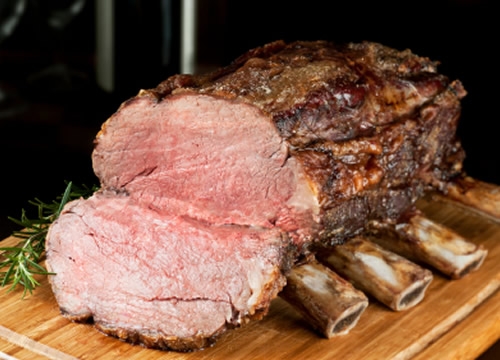
How Does a Standing Rib Roast Differ From A Prime Rib?
The terms “standing rib roast” and “prime rib” are often used interchangeably, and there’s a common misconception that they refer to different cuts of meat. However, in reality, they typically refer to the same thing: a cut of beef taken from the primal rib section of the animal.
The confusion arises from the fact that “standing rib roast” describes the cut before it’s cooked, emphasizing its bone-in presentation, while “prime rib” often refers to the same cut after it’s been cooked and sliced. A standing rib roast becomes prime rib once it’s been cooked and served.
However, there’s a subtle difference in how the terms are sometimes used. “Prime rib” may specifically refer to a standing rib roast that has been graded as “prime” by the USDA, indicating a higher quality of marbling and tenderness than lower grades like choice or select. On the other hand, “standing rib roast” is a more generic term that doesn’t necessarily denote a specific grade of beef.
While there may be a slight difference in how the terms are used in certain contexts, they generally refer to the same cut of beef: a succulent, flavorful roast taken from the rib section of the animal, typically cooked with the bones intact for added flavor and presentation.
Horseradish sauce is a piquant condiment that adds a zesty kick to various dishes. Made from grated horseradish root, vinegar, and often a touch of salt and sugar, this sauce boasts a sharp, tangy flavor profile that can awaken the taste buds and complement a variety of savory dishes.
The primary ingredient, horseradish root, lends the sauce its distinctive heat and pungency. When grated or ground, the root releases volatile compounds called isothiocyanates, which are responsible for its spicy kick and characteristic aroma. Vinegar serves to mellow the sharpness of the horseradish while providing acidity, which helps balance the flavors and preserve the sauce.
Horseradish Sauce
Horseradish sauce is incredibly versatile and can be used in numerous culinary applications. It is a classic accompaniment to roast beef, prime rib, and other hearty meats, where its bold flavor cuts through the meat’s richness, enhancing its overall taste.
Additionally, it can be mixed with mayonnaise or sour cream to create a creamy horseradish sauce, perfect for dipping fried foods, slathering on sandwiches, or serving alongside seafood dishes like smoked salmon or shrimp cocktails.
Whether used as a condiment, a dipping sauce, or an ingredient in recipes, horseradish sauce adds depth and complexity to dishes, making it a beloved staple in many kitchens worldwide. Its fiery flavor and versatility make it a go-to choice for those seeking to elevate the taste of their meals with a bold and distinctive condiment.
Standing Rib Roast Recipe
Ingredients
- 6 pound bone-in rib roast trimmed and tied (by butcher)
- Kosher salt and pepper to taste
- 6 tablespoons butter softened
- 1 tablespoon Dijon mustard
- tablespoon Worcestershire sauce
- 4 cloves garlic minced
- 1 tablespoon fresh rosemary leaves minced
Instructions
- Preheat the oven to 450°F.
- Place the rib roast, bone-side down, and fat-side up in a roasting pan that has been oiled. Season with salt and pepper.
- Place your thermometer in the thickest part of the roast being careful not to touch any bone.
- Sear the roast for 20 minutes in the hot oven. When done, remove from oven.
- While the roast is searing, mix the butter, mustard, Worcestershire sauce, garlic, rosemary, pepper, and salt in a bowl.
- When the roast is done searing, slather the butter paste over the sides and top of the roast.
- Lower the oven temperature to 350°F. and return the roast to the oven.
- Continue roasting until the thermometer reaches around 118°F. for medium rare.
- Remove the roast from the oven, place on a cutting board, cover with aluminum foil and let rest for about 20 minutes or until the internal temperature rises up to 125°F.
- Slice the rib roast, plate and serve.
Notes
Horseradish Sauce
Ingredients
- 1½ cups sour cream
- 1 tablespoon fresh lemon juice
- 8 ounces prepared horseradish
- ½ teaspoon Kosher salt
- fresh chives for garnish
Instructions
- In a small bowl, combine and whisk all the ingredients until combined and smooth.
- Garnish the sauce with the chives.
- Serve with the standing rib roast.

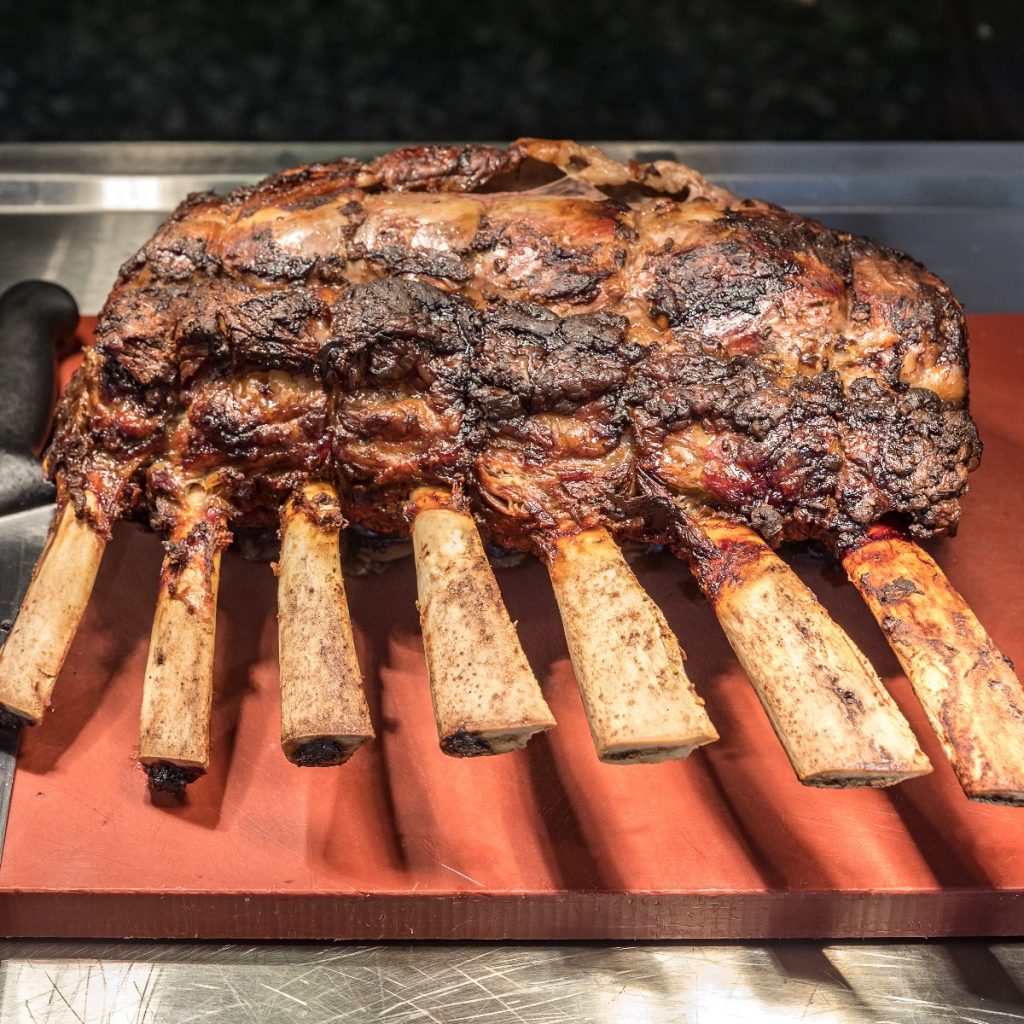
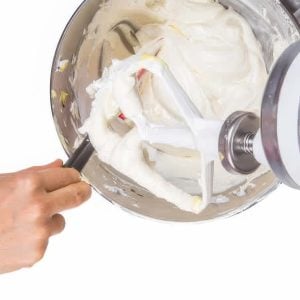
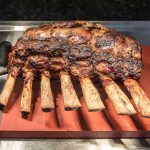


4 Responses
We had standing rib at my folk’s house. This is pretty much the way we did ours; it was fantastic!
Hi, I love all your recipes, so when I fell in love with the idea of having an English Christmas for 2010, I immediately looked at your web site for a rib roast/yorkshire pudding recipe and I will try this and let you know how it turns out! Merry Christmas!
Thanks Hansie. I’m going to a neighbors tonight for the same meal. Merry Christmas to you and have a great meal. – RG
Whoops, I forgot to post my thoughts last year! Well, I did it again this year (2011) so you know everyone enjoyed it. Happy 2012, and I look forward to browsing your web site for more delicious ideas.
I’m having a dinner party and looking for new roast recipes. This looks great.